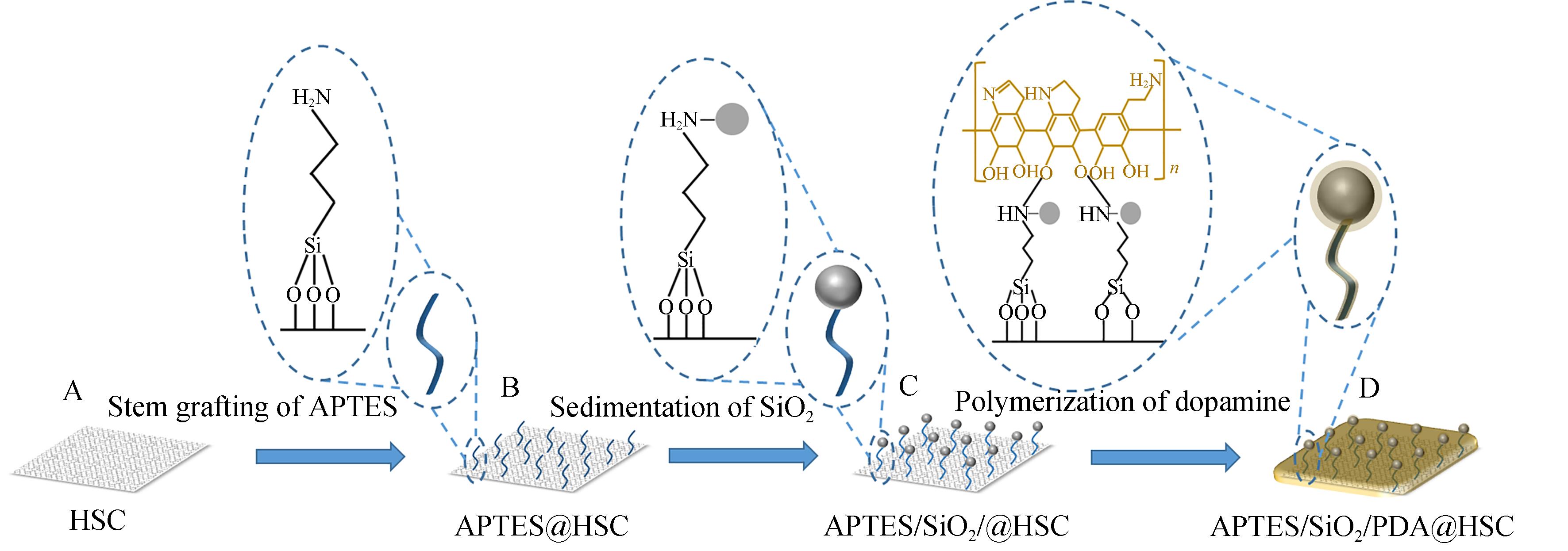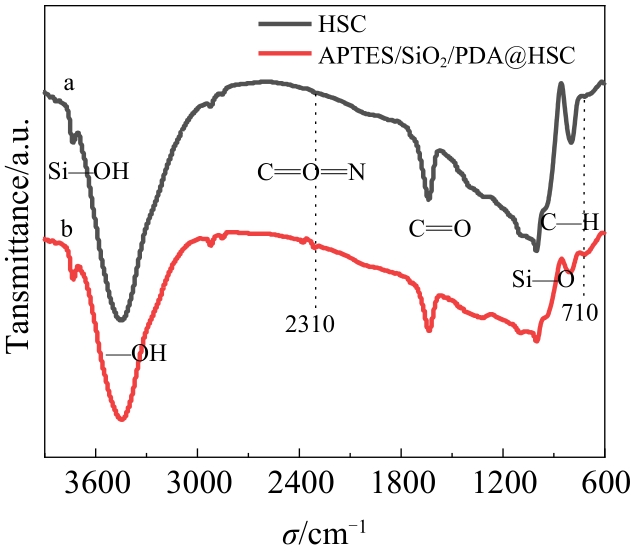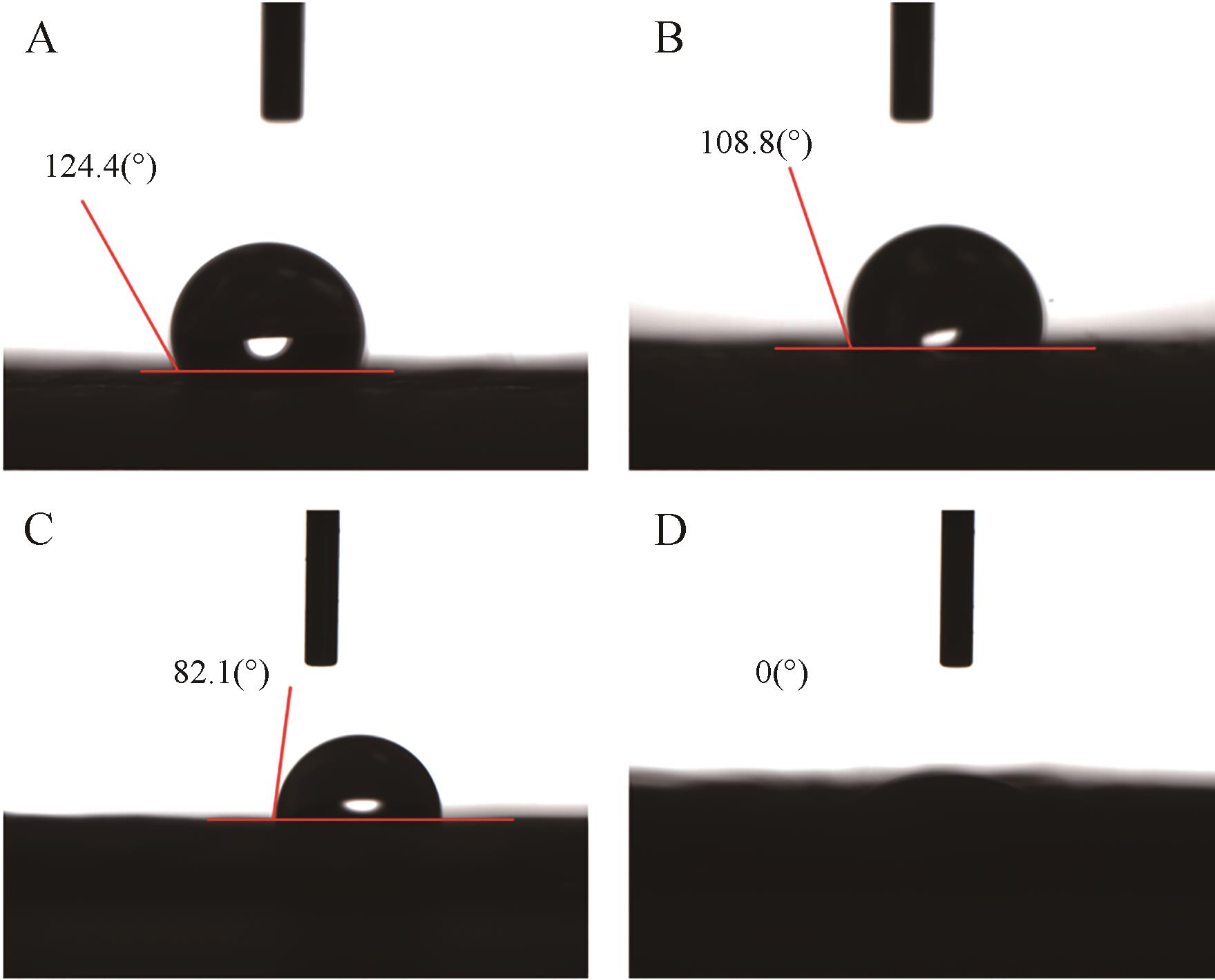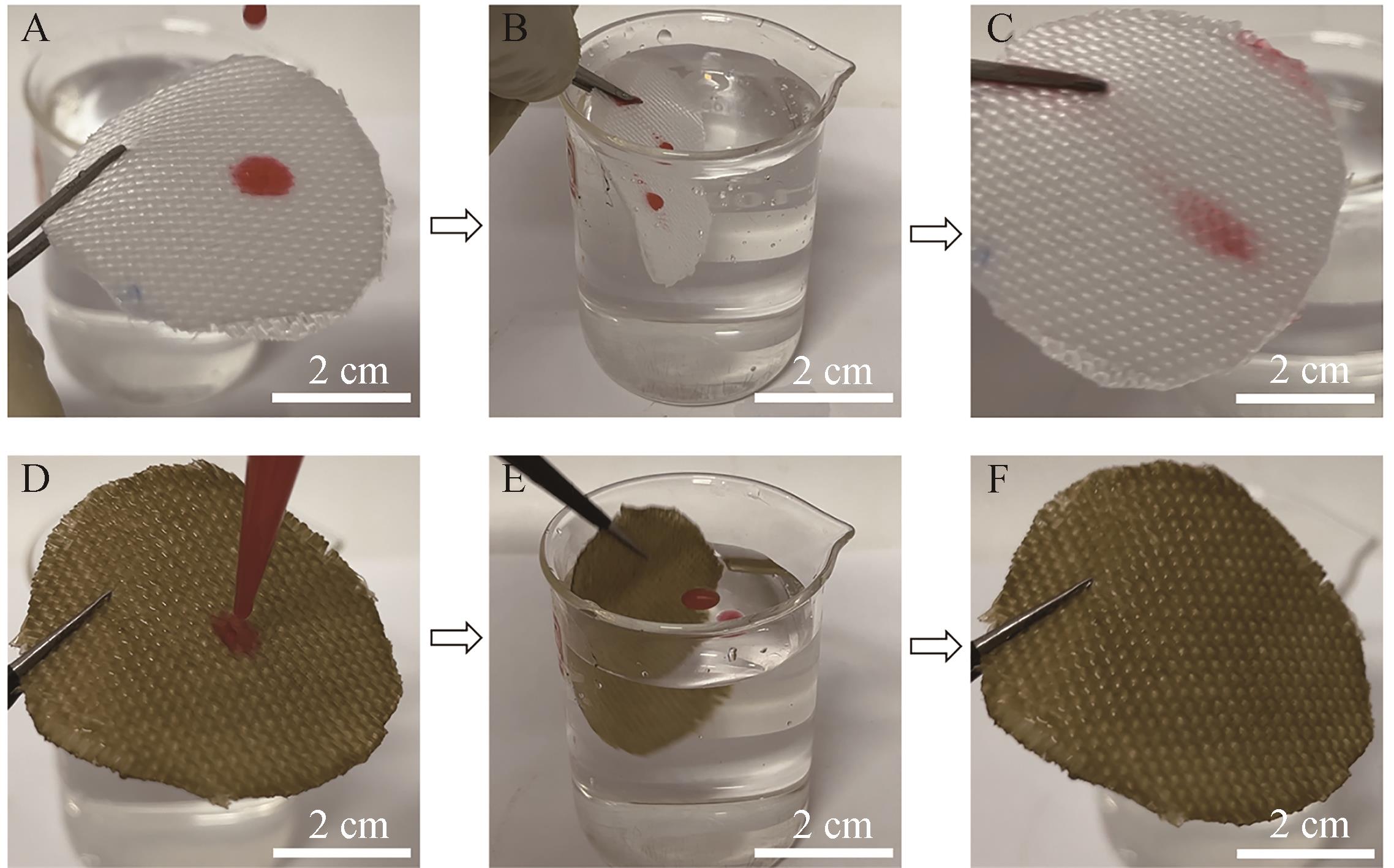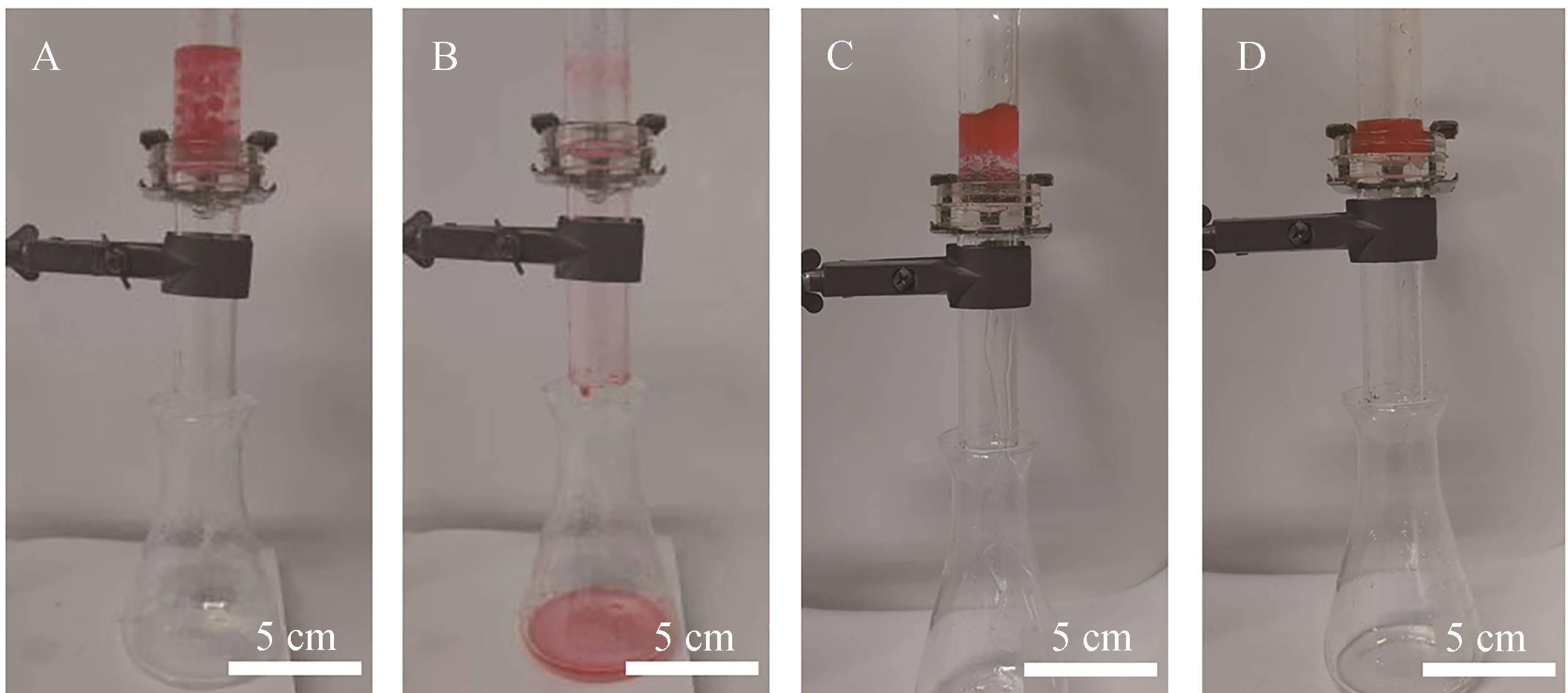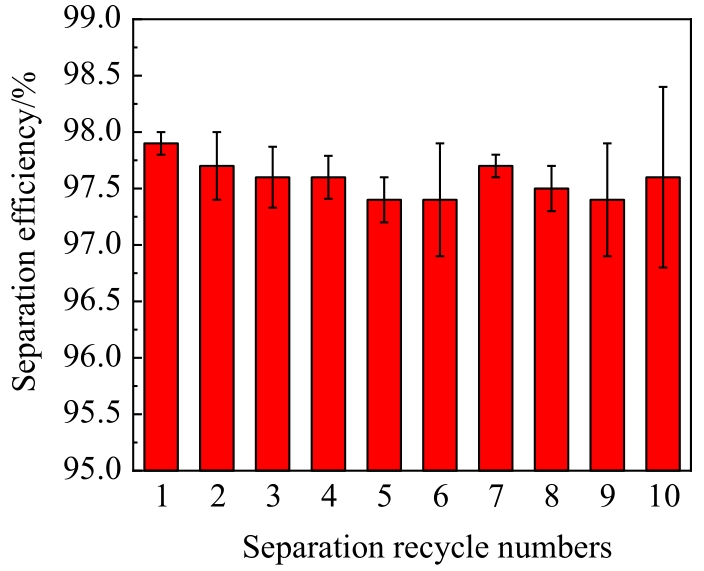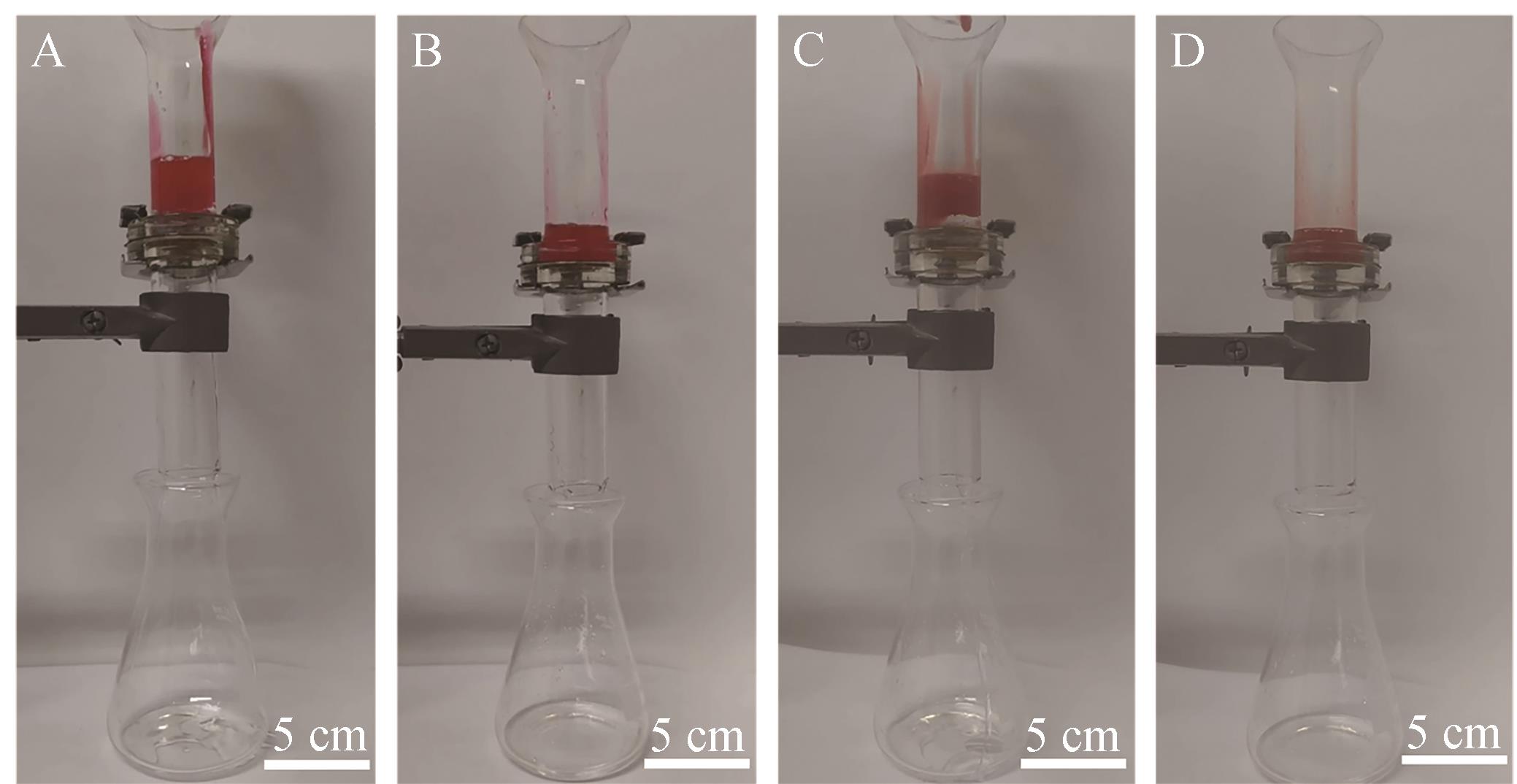
Chinese Journal of Applied Chemistry ›› 2023, Vol. 40 ›› Issue (3): 449-459.DOI: 10.19894/j.issn.1000-0518.220296
• Full Papers • Previous Articles Next Articles
Preparation of Super-hydrophilic/Underwater Oil-phobic High Silicon Cloth and Its Oil-water Separation Performance
Nan-Yu LIN, Feng GAO( ), Jiang-Ying QU, Jing-Jing TU, Wei-Jun ZHONG, Yun-Hao ZANG
), Jiang-Ying QU, Jing-Jing TU, Wei-Jun ZHONG, Yun-Hao ZANG
- School of Environment and Civil Engineering,Dongguan University of Technology,Dongguan 523808,China
-
Received:2022-09-02Accepted:2023-02-18Published:2023-03-01Online:2023-03-27 -
Contact:Feng GAO -
About author:fenggao2003@163.com
-
Supported by:the National Nature Science Foundation of China(51972059)
CLC Number:
Cite this article
Nan-Yu LIN, Feng GAO, Jiang-Ying QU, Jing-Jing TU, Wei-Jun ZHONG, Yun-Hao ZANG. Preparation of Super-hydrophilic/Underwater Oil-phobic High Silicon Cloth and Its Oil-water Separation Performance[J]. Chinese Journal of Applied Chemistry, 2023, 40(3): 449-459.
share this article
Add to citation manager EndNote|Ris|BibTeX
URL: http://yyhx.ciac.jl.cn/EN/10.19894/j.issn.1000-0518.220296

Fig.8 (A) UV-Vis scan of gasoline-water mixture separation filter after extraction; (B) Oil content of filter and separation efficiency; (C) Membrane flux of water and gasoline-water mixture of HSC, 50 nm SiO2/PDA@HSC, APTES/50 nm SiO2@HSC, APTES/PDA@HSC and APTES/50 nm SiO2/PDA@HSC
| Oil-water flux/(L·m-2·h-1) | Pure water flux/(L·m-2·h-1) | Ref. | |
|---|---|---|---|
| 1 | — | 6 369 | [ |
| 2 | 1389±67 | — | [ |
| 3 | — | 9 700 | [ |
| 4 | 762 | — | [ |
| 5 | 1720±20 | — | [ |
| 6 | 7184 | 11 465 | This work |
Table 1 Comparison of membrane flux between this work and other work
| Oil-water flux/(L·m-2·h-1) | Pure water flux/(L·m-2·h-1) | Ref. | |
|---|---|---|---|
| 1 | — | 6 369 | [ |
| 2 | 1389±67 | — | [ |
| 3 | — | 9 700 | [ |
| 4 | 762 | — | [ |
| 5 | 1720±20 | — | [ |
| 6 | 7184 | 11 465 | This work |

Fig.9 (A) UV-Vis scan of gasoline-water mixture separation filter after extraction, (B) oil content of filter and separation efficiency and (C) membrane flux of water and gasoline-water mixture of HSC and APTES/x nm SiO2/PDA@HSC(x=50,300,500)
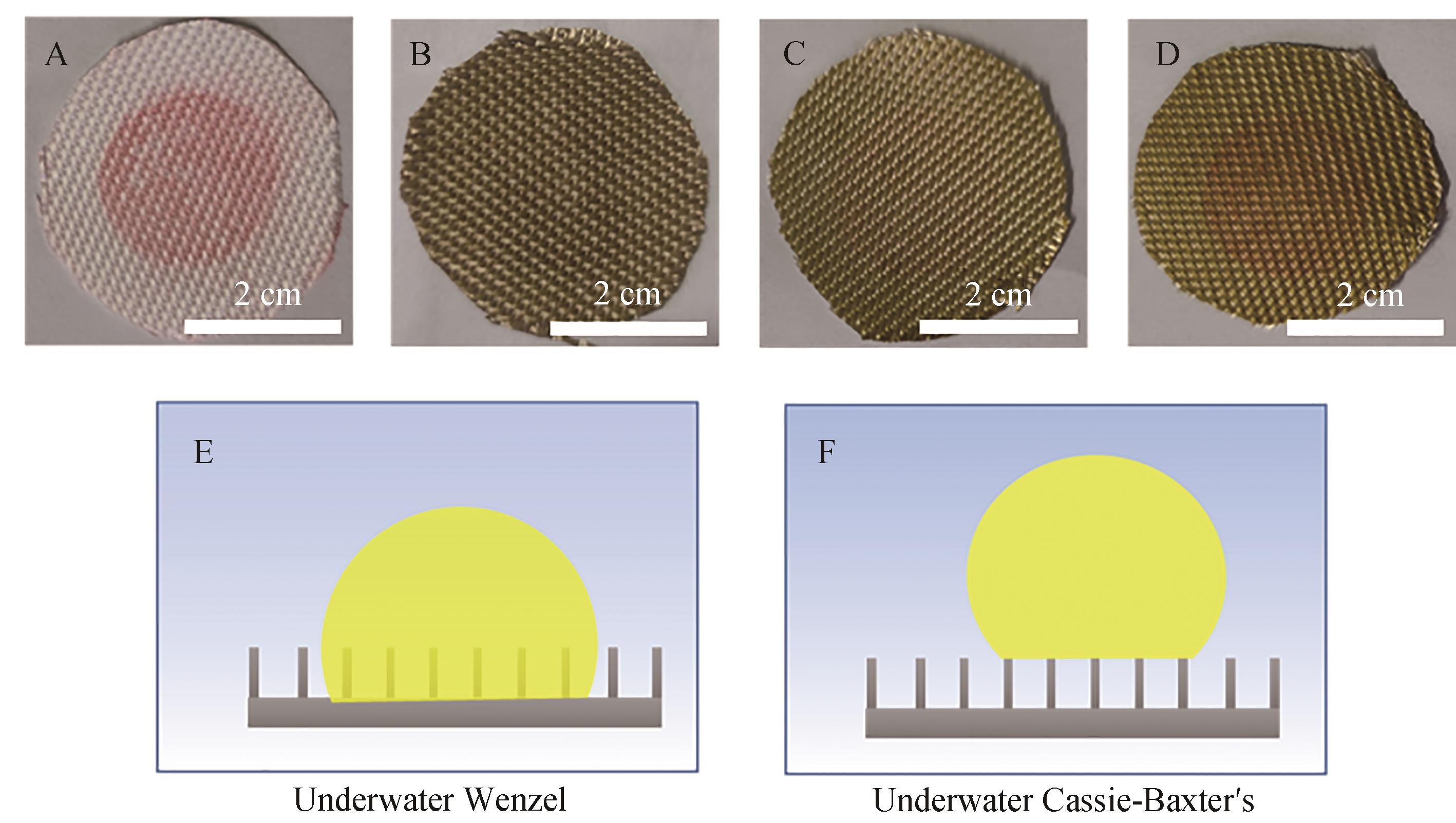
Fig.10 Membrane surfaces after gasoline-water mixture separation (gasoline incarnadined by oil red O) (A)HSC, (B) APTES/50 nm SiO2/PDA@HSC, (C) APTES/300 nm SiO2/PDA@HSC, (D) APTES/500 nm SiO2/PDA@HSC, (E, F) are the Wenzel state and Cassie-Baxter′s state of underwater oil contact angle, respectively
| 1 | LIU Q, PATEL A A, LIU L. Superhydrophilic and underwater superoleophobic poly(sulfobetaine methacrylate)-grafted glass fiber filters for oil-water separation[J]. ACS Appl Mater Inter, 2014, 6(12): 8996-9003. |
| 2 | 李文涛, 雍佳乐, 杨青, 等. 基于特殊润湿性材料的油水分离[J]. 物理化学学报, 2018, 34(5): 456-475. |
| LI W T, YONG J L, YANG Q, et al. Oil-water separation base on the materials with special wettability[J]. Chin Acta Phys-Chim Sin, 2018, 34(5): 456-475. | |
| 3 | 彭华乔, 石涛, 薛森, 等. 用于油水分离超疏水材料的研究进展[J]. 化工新型材料, 2021, 49(7): 39-41, 51. |
| PENG H Q, SHI T, XUE S, et al. Reasearch progress on superhydrophobic material for oil-water separation[J]. Chin New Chem Mater, 2021, 49(7): 39-41,51. | |
| 4 | IVSHINA I B, KUYUKINA M S, KRIVORUCHKO A V, et al. Oil spill problems and sustainable response strategies through new technologies[J]. Environ Sci: Proc Imp, 2015, 17(7): 1201-1219. |
| 5 | 江雷. 从自然到仿生的超疏水纳米界面材料[J]. 化工进展, 2003(12): 1258-1264. |
| JIANG L. Nanostructured materials with superhydrophobic surface-from nature to biomimesis[J]. Chin Chem Ind Eng Prog, 2003(12): 1258-1264. | |
| 6 | 王鹏伟, 刘明杰, 江雷. 仿生多尺度超浸润界面材料[J]. 物理学报, 2016, 65(18): 61-83. |
| WANG P W, LIU M J, JIANG L. Bioinspired multiscale interfacial materials with superwettability[J]. Chin Acta Phy Sin, 2016, 65(18): 61-83. | |
| 7 | QU M, LIU Q, LIU L, et al. A superwettable functionalized-fabric with pH-sensitivity for controlled oil/water, organic solvents separation, and selective oil collection from water-rich system[J]. Sep Purif Technol, 2021, 254: 117665. |
| 8 | 侯琳刚, 马利利, 周亦晨, 等. 低表面能化合物在超浸润材料中的应用[J]. 化学进展, 2018, 30(12): 1887-1898. |
| HOU L G, MA L L, ZHOU Y C, et al. Application of low surface energy compounds to the superwetting materials[J]. Prog Chem, 2018, 30(12): 1887-1898. | |
| 9 | FENG L, ZHANG Z, MAI Z, et al. A super-hydrophobic and super-oleophilic coating mesh film for the separation of oil and water[J]. Angew Chem Int Ed Engl, 2004, 43(15): 2012-2014. |
| 10 | CRICK C R, GIBBINS J A, PARKIN I P. Superhydrophobic polymer-coated copper-mesh; membranes for highly efficient oil-water separation[J]. J Mater Chem A, 2013, 1(19): 5943-5948. |
| 11 | QIU L, ZHANG J, GUO Z, et al. Asymmetric superwetting stainless steel meshes for on-demand and highly effective oil-water emulsion separation[J]. Sep Purif Technol, 2021, 273: 118994. |
| 12 | ZHANG L, HE Y, LUO P, et al. Photocatalytic GO/M88A “interceptor plate” assembled nanofibrous membrane with photo-Fenton self-cleaning performance for oil/water emulsion separation[J]. Chem Eng J, 2022, 427: 130948. |
| 13 | WANG H, LI J, YU X, et al. Facile fabrication of super-hydrophilic cellulose hydrogel-coated mesh using deep eutectic solvent for efficient gravity-driven oil/water separation[J]. Cellulose, 2020, 28(2): 949-960. |
| 14 | SUN F, LI T T, REN H T, et al. Dopamine-decorated lotus leaf-like PVDF/TiO2 membrane with underwater superoleophobic for highly efficient oil-water separation[J]. Proc Saf Environ Prot, 2021, 147: 788-797. |
| 15 | SONG P, LU Q. Porous clusters of metal-organic framework coated stainless steel mesh for highly efficient oil/water separation[J]. Sep Purif Technol, 2020, 238: 116454. |
| 16 | ZUO J H, CHENG P, CHEN X F, et al. Ultrahigh flux of polydopamine-coated PVDF membranes quenched in air via thermally induced phase separation for oil/water emulsion separation[J]. Sep Purif Technol, 2018, 192: 348-359. |
| 17 | YOU H, SONG G, LIU Q, et al. A facile route for the fabrication of a superhydrophilic and underwater superoleophobic phosphorylated PVA-coated mesh for both oil/water immiscible mixture and emulsion separation[J]. Appl Surf Sci, 2021, 537: 147986. |
| 18 | YIN Y, ZHU L, GUO T, et al. Microphone-like Cu-CAT-1 hierarchical structures with ultra-low oil adhesion for highly efficient oil/water separation[J]. Sep Purif Technol, 2020, 241: 116688. |
| 19 | ZHENG L, LI H, LAI X, et al. Superwettable Janus nylon membrane for multifunctional emulsion separation[J]. J Mem Sci, 2022, 642: 119995. |
| 20 | 元博, 宋高臣, 李莹, 等. Tris缓冲体系下NiTi表面制备聚多巴胺薄膜提高其耐蚀性能[J]. 化工管理, 2019(4): 91-92. |
| YUAN B, SONG G C, LI Y, et al. Polydopamine film was prepared on NiTi surface under Tris buffering system to improve its corrosion resistance[J]. Chem Enter Manage, 2019(4): 91-92. | |
| 21 | 闵璐. UV2100紫外可见分光光度计在污水分析的应用[J]. 科技创新与应用, 2016(24): 80. |
| MIN L. Application of UV2100 ultraviolet visible spectrophotometer in sewage analysis[J]. Technol Innov Appl, 2016(24): 80. | |
| 22 | 魏强兵, 岳芹宇, 李乐乐, 等. 聚多巴胺辅助两性离子聚合物界面组装制备水润滑纳米涂层[J]. 摩擦学学报, 2019, 39(4): 387-395. |
| WEI Q B, YUE Q Y, LI L L, et al. Polydopamine assisted Co-assembly for fabrication of zwitterionic polymer nanocoating with efficient aqueous lubrication[J]. Tribology, 2019, 39(4): 387-395. | |
| 23 | 楚刚辉, 刘琴. 聚多巴胺包覆氨基硅球用于木犀草素的富集及检测[J]. 化学研究与应用, 2020, 32(3): 429-435. |
| CHU G H, LIU Q. Enrichment and dermination of luteolin by ploydopamine-coated amino silica[J]. Chem Res Appl, 2020, 32(3): 429-435. | |
| 24 | WANG R, ZHAO X, JIA N, et al. Superwetting oil/water separation membrane constructed from in situ assembled metal-phenolic networks and metal-organic frameworks[J]. ACS Appl Mater Inter, 2020, 12(8): 10000-10008. |
| 25 | VELAYI E, NOROUZBEIGI R. A mesh membrane coated with dual-scale superhydrophobic nano zinc oxide: efficient oil-water separation[J]. Sur Coat Technol, 2020, 385: 125394. |
| 26 | QI Z, SHI G G, SUN Q, et al. Robust PVA-GO-TiO2 composite membrane for efficient separation oil-in-water emulsions with stable high flux[J]. J Membr Sci, 2021, 640: 119836. |
| 27 | WU M M, XIANG B, MU P, et al. Janus nanofibrous membrane with special micro-nanostructure for highly efficient separation of oil-water emulsion[J]. Sep Purif Technol, 2022, 297: 121532. |
| 28 | JUNG Y C, BHUSHAN B. Wetting behavior of water and oil droplets in three-phase interfaces for hydrophobicity/philicity and oleophobicity/philicity[J]. Langmuir, 2009, 25(24): 14165-14173. |
| [1] | Xiao-Jian DING, Cong-Jun CAO, Cheng-Min HOU, Han-Xiao MA, Jiao HU, Meng-Jie REN, Guo-Yong YANG. Preparation and Performance of Environmentally Friendly Fluorine⁃Free Superhydrophobic Fabric for Oil/Water Separation [J]. Chinese Journal of Applied Chemistry, 2022, 39(9): 1391-1400. |
| [2] | ZHANG Jingjing, XIAO Xin, SHI Dongjian, CHEN Mingqing. Morphology Regulation of Polydopamine Self-polymerization on the Surface of Strongly Electronegative Microspheres [J]. Chinese Journal of Applied Chemistry, 2020, 37(7): 756-763. |
| [3] | WANG He, LUO Jing, LI Xiaojie, SHI Dongjian, CHEN Mingqing. Efficient Preparation of Polydopamine Nanoparticles by Precipitation [J]. Chinese Journal of Applied Chemistry, 2019, 36(2): 155-160. |
| [4] | Shuang LENG, Tao WANG, Min YANG, Yanzhi ZHAO, Wei LU, Ruoming WANG, Guoying SUN. Preparation and Electrochemical Performance of Nitrogen Doped Carbon Materials Based on Polydopamine [J]. Chinese Journal of Applied Chemistry, 2018, 35(4): 477-483. |
| [5] | SHI Yanlong, WANG Zhidan, FANG Yun, LYU Tao, FENG Xiaojuan, FENG Lei, YANG Wu. Fabrication of Superhydrophobic-Superoleophilic Copper Mesh and Its Application in Oil-Water Separation [J]. Chinese Journal of Applied Chemistry, 2017, 34(4): 472-480. |
| [6] | XIE Dandan, YAN Liang, YIN Yuli, ZHANG Zhaohui, WANG Jing. Preparation and Application of Magnetic Multi-ion Imprinted Polymers Based on Multiwalled Carbon Nanotubes [J]. Chinese Journal of Applied Chemistry, 2017, 34(4): 456-463. |
| [7] | YANG Xiaotian, SHUAI Qian, LUO Yanmei, DONG Yike, TAN Yueming, CHEN Bo, MA Ming. Fabrication and Application of the Superhydrophobic Sponge Modified with Poly(dimethylsiloxane)/Silver Micro/Nano-particles/Polydopamine [J]. Chinese Journal of Applied Chemistry, 2015, 32(6): 726-732. |
| [8] | ZHOU Cong1, CHEN Shuo2, ZHU Weitao1, YUAN Ping1, YANG Zihui1, LI Bin1, CHEN Bo1*. Preparation and Application of Super-hydrophobic Filter Paper [J]. Chinese Journal of Applied Chemistry, 2012, 29(03): 297-303. |
| Viewed | ||||||
|
Full text |
|
|||||
|
Abstract |
|
|||||
